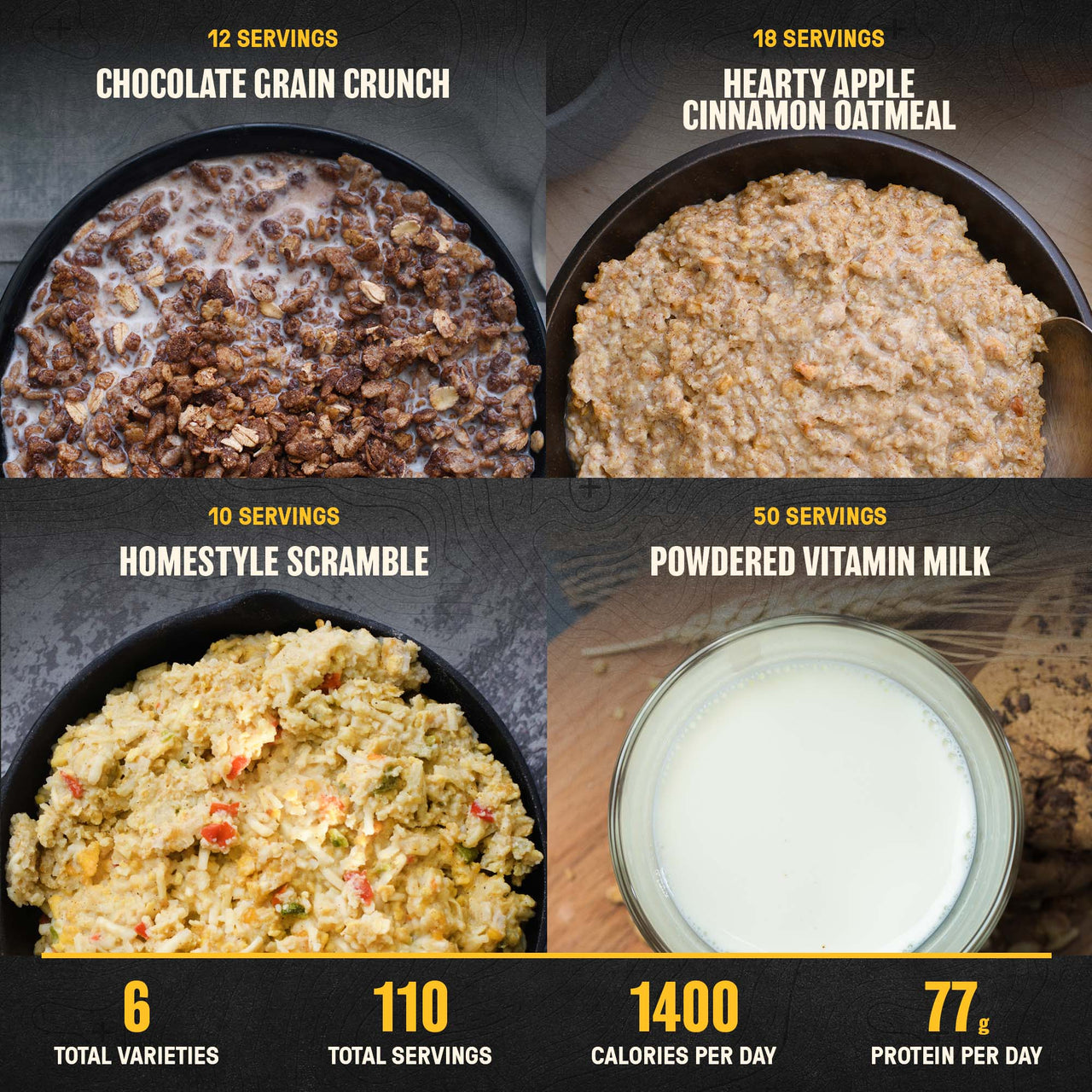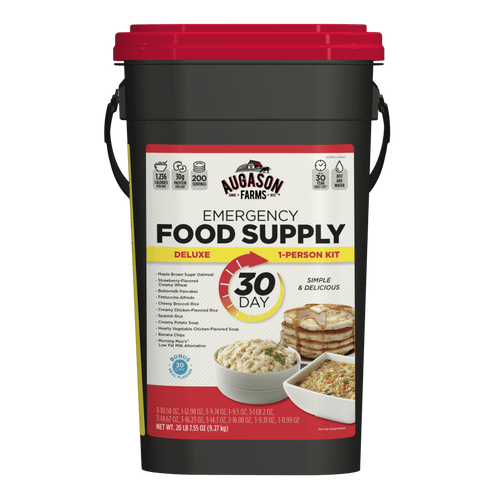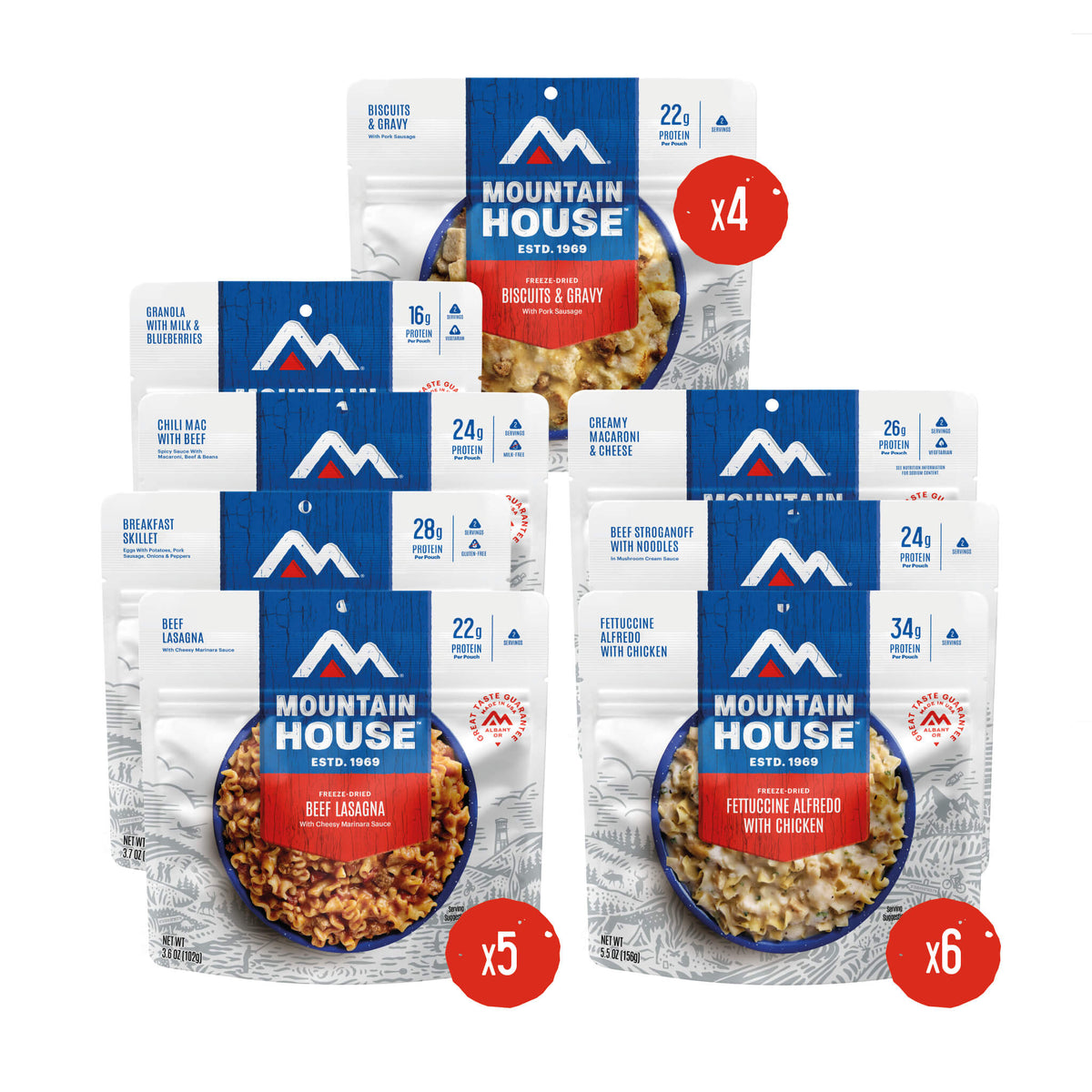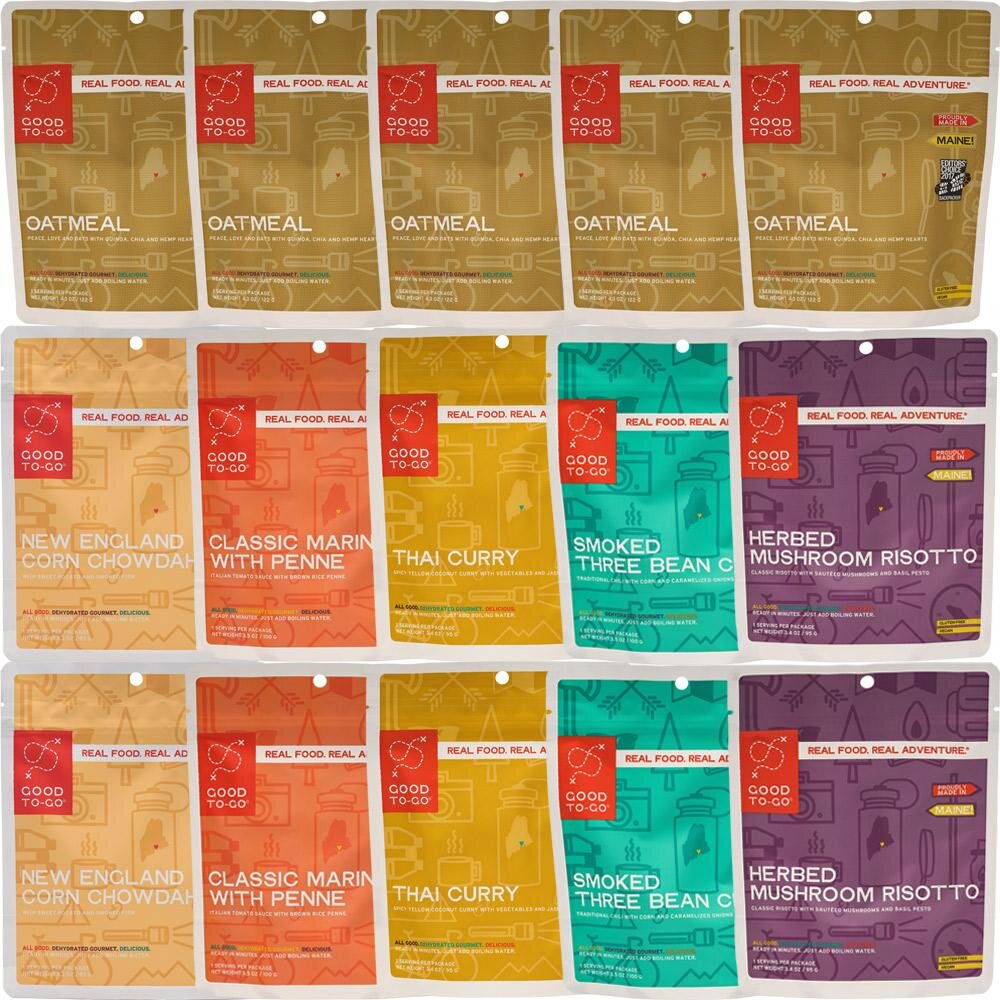Best Emergency Kit Nutrient Rich Survival Food Kits for 2025
by Brett Roberts
·
Introduction: Why Nutrient-Rich Emergency Foods Matter More Than Ever in 2025
In today’s unpredictable world, being prepared for natural disasters and everyday emergency situations isn’t just for the overly cautious—it’s smart emergency preparedness. Whether you’re facing an extreme weather-related event, a neighbourhood power outage, or you’re off-grid for a weekend, having emergency food kits with a long shelf life delivers genuine peace of mind.
But it’s not just about stockpiling enough food—it’s about having the best options that meet your nutritional needs. In high-stress scenarios, your body needs more than calories; it needs essential nutrients and essential nutrition to maintain energy, focus, and overall health. That’s where nutrient-rich survival foods—often freeze-dried meals and other shelf-stable emergency food packs—shine.
This guide walks you through the best survival food kits for 2025, how to evaluate them, and which choices fit different scenarios—from long-term food storage at home to outdoor adventures. We’ll also touch on dietary needs and dietary restrictions (including gluten-free foods) so your emergency supplies truly work when you need them.
What Are Nutrient-Rich Survival Foods?
These are purpose-built foods that go beyond basic calories. Designed to deliver nutritional value—protein, complex carbohydrates, healthy fats, vitamins, minerals, and amino acids—they help sustain energy levels over an extended period. Unlike random pantry items from the grocery store, they’re engineered so meals meet nutritional standards for emergency meals and emergency survival food.
Why They Matter in Emergencies
When access to fresh food is disrupted by natural disasters, unforeseen circumstances, or remote travel, relying on only high-calorie, low-nutrient items can cause energy crashes. Freeze-dried foods (including freeze-dried fruits), hearty staples like creamy potato soup and hearty soups, and dense staples like peanut butter offer the best way to keep energy levels stable. In a case of an emergency, pairing emergency food kits with water supplies, first aid kits, and a compact emergency stove is a good idea.
Section 2: Evaluation Criteria for Survival Foods
-
Shelf Life
Look for a remarkable 25-year shelf life (or comparable long shelf life). Brands achieve this through freeze-drying, oxygen absorbers, and robust packaging. Store in ideal storage conditions—cool, dark places—to maximise the shelf life of those products. This supports long term resilience. -
Nutritional Content
Prioritise essential nutrients and overall nutritional value. The best emergency food supplies balance macros and micros so meals meet realistic nutritional standards—not just calories. -
Ease of Preparation
During outages, you may only have hot water (or even cold). Choose options that re hydrate quickly. That’s a better option than foods requiring long cook times and hard work. -
Taste & Variety
Morale matters. A mix of freeze-dried meals, hearty soups, creamy potato soup, breakfast items, and snacks (e.g., freeze-dried fruits, peanut butter) prevents menu fatigue. -
Portability & Packaging
Compact, resealable pouches are easier to move in evacuations. Buckets help organise much food and protect your supply of food. -
Value & Total Servings
Compare price points, servings, calories, and nutrition per serve. The best emergency food supply kits balance cost with quality and longevity.
Section 3: Top Emergency Kit Nutrient-Rich Survival Foods for 2025
In this section, we'll evaluate some of the top emergency food kits available in 2025. Each product will be assessed based on the criteria established earlier: shelf life, nutritional content, ease of preparation, taste and variety, portability and packaging, and value and total servings. We'll assign a score out of 10 for each criterion and calculate an overall score out of 10 for each product.
1. Nutrient Survival 14-Day Emergency Food Kit
Overview: High-nutrition meals targeting vitamins, minerals, protein, and amino acids for sustained energy levels.
-
Shelf Life: Up to 25 years.
-
Nutrition: Strong on essential nutrients; meals meet robust standards.
-
Prep: Just add hot water.
-
Taste & Variety: From Homestyle Scramble to Hearty Lasagna.
-
Portability: Resealable pouches for long-term food storage.
-
Value: 120 servings (approx. 2,100 kcal/day).
-
Overall Score: 9.0/10

Nutrient Survival 14 Day Emergency Food Kit
2. ReadyWise Emergency Food Supply Bucket
ReadyWise Emergency Food Supply
Overview: A family-friendly bucket with diverse freeze-dried meals.
-
Shelf Life: ~25 years.
-
Nutrition: Balanced nutritional value.
-
Prep: Add water.
-
Taste & Variety: 13 meals, including pastas and rice dishes.
-
Portability: Durable bucket.
-
Value: 120 servings at competitive price points.
-
Overall Score: 8.7/10
3. Augason Farms 30-Day Emergency Food Supply

Overview: Augason Farms offers substantial servings for households wanting enough food on hand.
-
Shelf Life: Up to 25 years.
-
Nutrition: Solid nutritional value across staples.
-
Prep: Requires boiling water.
-
Taste & Variety: 11 meal options (think oatmeal, soups, and pasta).
-
Portability: Lidded bucket simplifies storage.
-
Value: 307 servings; strong per-serve cost.
-
Overall Score: 8.5/10
4. Mountain House 14-Day Emergency Food Supply

Overview: Mountain House (famous for freeze-dried meals) with a 30-year taste guarantee.
-
Shelf Life: 30 years.
-
Nutrition: Balanced; dependable nutritional value.
-
Prep: Add hot water; ready fast.
-
Taste & Variety: Favourites like Beef Stroganoff and Breakfast Skillet.
-
Portability: Lightweight pouches—ideal for grab-and-go.
-
Value: 42 servings; premium brand reputation and positive reviews.
-
Overall Score: 8.8/10
5. Good To-Go Emergency Food Kit

Good To Go Essential Emergency Food Kit
Overview: Chef-crafted meals from Good To-Go, Inc. (Kittery, Maine, USA)—great for dietary restrictions.
-
Shelf Life: ~5 years.
-
Nutrition: Real-ingredient recipes; handmade meals with clean labels.
-
Prep: Boiling water.
-
Taste & Variety: Gourmet-leaning flavours; strong with gluten-free foods and other dietary needs.
-
Portability: Lightweight pouches.
-
Value: Varies by kit size.
-
Overall Score: 8.0/10
Other reputable survival food companies you’ll see in the market include Valley Food Storage, Patriot Supply, and speciality bundles like Famine Fighter. As always, check brand privacy policy, allergens, and basic information before buying. Some shoppers keep an eye out for exclusive deals around seasonal sales.
Section 4: Comparative Analysis
To help you make an informed decision, we've compiled a comparison table highlighting the key features of the top emergency food kits discussed earlier. This table evaluates each product based on shelf life, nutritional content, ease of preparation, taste and variety, portability and packaging, and value and total servings.
Comparison Table
|
Product Name |
Shelf Life |
Nutritional Content |
Ease of Preparation |
Taste & Variety |
Portability & Packaging |
Value & Total Servings |
Overall Score |
|
Nutrient Survival 14-Day Kit |
25 years |
High |
Easy |
Good |
Excellent |
Moderate |
9.0/10 |
|
ReadyWise Emergency Food Supply |
25 years |
Moderate |
Very Easy |
Good |
Good |
High |
8.7/10 |
|
Augason Farms 30-Day Supply |
25 years |
Moderate |
Easy |
Good |
Good |
Very High |
8.5/10 |
|
Mountain House 14-Day Supply |
30 years |
High |
Very Easy |
Excellent |
Excellent |
Moderate |
8.8/10 |
|
Good To-Go Emergency Food Kit |
5 years |
High |
Easy |
Excellent |
Excellent |
Moderate |
8.0/10 |
Insights
-
Best for Long-Term Storage: Mountain House (30-year shelf life).
-
Best Nutritional Focus: Nutrient Survival (strong micronutrient profile).
-
Best Value/Servings: Augason Farms (generous total serves).
-
Best for Dietary Restrictions: Good To-Go (clean, real-ingredient, gluten-free options available).
Section 5: Recommendations Based on Specific Needs
-
Outdoor Recreation / 3-Day Food Supply:
Mountain House pouches are compact and fast with hot water—great in a pack with a small emergency stove. Consider a best car emergency kits stash for vehicles too. -
Home Emergency Preparedness:
ReadyWise and Augason Farms buckets provide lots of servings and tidy long-term food storage. Pair with water supplies and first aid kits. -
Budget Stretchers:
Augason Farms delivers much food per dollar at accessible price points. -
Dietary Needs / Restrictions:
Good To-Go offers handmade meals with clean labels and gluten-free foods; also look to Valley Food Storage assortments for specialised types of food. -
High-Nutrition Daily Baseline:
Nutrient Survival emphasises essential nutrition that helps maintain energy levels over an extended period.
Pro tip: Garden produce from your own backyard can complement kits during a food shortage or supply disruption, reducing reliance on the grocery store.
Conclusion: Build a Resilient, Right-Sized Emergency Pantry
Emergencies—from natural disasters to grid hiccups—can arrive fast. Choosing best emergency food supplies with a long shelf life, solid nutritional value, easy hot water prep, and practical packaging is the best way to get genuine peace of mind. Mix brands (e.g., Mountain House, Augason Farms, Good To-Go) to cover dietary restrictions, price points, and taste preferences, and keep your emergency supply kit together with water supplies, first aid kits, and a compact emergency stove. Review kits annually, rotate older items, and store in ideal storage conditions (cool, dark places). That’s how real households—real people—stay ready.
Frequently Asked Questions (FAQs)
1) How much should I store?
Start with a 3-day food supply per person, then scale to 14–30 days depending on risk, household size, and emergency preparedness goals. Ensure enough food and water per person.
2) Do any kits work for strict dietary needs?
Yes. Look for labels indicating dietary needs or dietary restrictions support (e.g., gluten-free foods or vegetarian). Good To-Go and Valley Food Storage offer strong options.
3) Are these the same meals used by the armed forces?
Not exactly. While some techniques came from rations used by the armed forces and United States military, consumer kits focus on household practicality. For field-ration context, some readers browse Department of Defense pubs (AR) for basic information—but consumer products prioritise flavour, variety, and easy prep at home.
4) I’ve heard former special operators recommend certain brands—worth it?
Some guides by former Navy SEALs (e.g., Cade Courtley, who has years of active duty) discuss readiness mindsets. Take inspiration, but buy what fits your household’s nutritional needs, storage, and budget. There’s no single best choice for everyone.
5) Any safety/storage tips?
Keep kits in dark places with stable temperature and low humidity—the ideal storage conditions. Rotate stock and note the shelf life of those products on the bin. Many premium kits advertise a remarkable 25-year shelf life under proper storage.
6) Can I cook these without power?
Yes—most rehydrate with hot water from a camp stove. If you can’t heat water, some are edible with cold water, just slower. A compact emergency stove is a good option.
7) Any brands from Maine, USA?
Yes—Good To-Go, Inc., Kittery, Maine, USA produces chef-crafted, handmade meals and publishes a clear privacy policy. (Always review policies and allergens before purchasing.)
8) Are there government-endorsed kits?
Household kits aren’t “approved” by the US federal government; however, emergency agencies publish planning guidance. Choose reputable brands with years of experience and positive reviews from real people.
9) What about “Patriot Supply,” “Famine Fighter,” and similar bundles?
These survival food companies and themed bundles exist; compare price points, servings, and nutrition. Also consider niche sellers like Valley Food Storage.
10) What do I pair with food kits?
Water storage, filters, first aid kits, lighting, comms, hygiene, and a small emergency stove. Keep it all together as an emergency supply kit so you can move fast.
